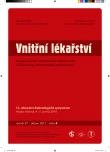Xerostomia, hyposialia, sicca syndrome – quantitative disturbances of the salivary flow rate
Authors:
R. Slezák 1; I. Berglová 1,2; J. Krejsek 2
Authors‘ workplace:
Stomatologická klinika Lékařské fakulty UK a FN Hradec Králové, přednosta doc. MUDr. Radovan Slezák, CSc.
1; Ústav klinické imunologie a alergologie Lékařské fakulty UK a FN Hradec Králové, přednosta prof. RNDr. Jan Krejsek, CSc.
2
Published in:
Vnitř Lék 2011; 57(4): 339-346
Category:
12th national Symposium diabetes, "Diabetes and Gastroenterology", Hradec Kralove, 4 to 5 June 2010
Overview
Diseases od salivary glands may be associated with salivary flow rate disturbances. Production of the saliva is evaluated by sialometric tests. The stress is putted on salivary flow rate disturbances in Sjögren’s syndrome, drug-induced and postirradiative sialopathy, and diabetes mellitus. The possibility of the stimulation and substitution of the saliva is discussed.
Key words:
salivary glands – salivary flow rate – hyposialia – xerostomia – sialometry – Sjögren’s syndrome – diabetes mellitus – sialogogues
Sources
1. Carlson ER, Ord RA (eds). Textbook and color atlas of salivary gland pathology. Diagnosis and management. Ames, Iowa: Wiley-Blackwell Publishing2008.
2. Mandel L, Surattanont F. Bilateral parotid swelling: A review. Oral Surg Oral Med Oral Pathol Oral Radiol Endod 2002; 93: 221–237.
3. Slezák R, Kudiyirickal MG, Nováková V et al. Stručný přehled nemocí slinných žláz a poruch salivace. Folia Parodontol Bohem 2008; 4: 16–25.
4. Young W, Khan F, Brandt R et al. Syndromes with salivary dysfunction predispose to tooth wear: Case reports of congenital dysfunction of major salivary glands, Prader-Willi, congenital rubella, and Sjögren’s syndromes. Oral Surg Oral Med Oral Pathol Oral Radiol Endod 2001; 92: 38–48.
5. Grisius MM. Salivary gland dysfunction: A review of systemic therapies. Oral Surg Oral Med Oral Pathol Oral Radiol Endod 2001; 92: 156–162.
6. Scully C. Drug effects on salivary glands: dry mouth. Oral Dis 2003; 9: 165–176.
7. Turner JR, Sugiya H. Understanding salivary fluid and protein secretion. Oral Dis 2002; 8: 3–11.
8. Ferguson DB. The physiology and biology of saliva. In: deBurgh Norman JE, McGurk M (eds). Color Atlas and Text of the Salivary Glands Diseases, Disorders and Surgery. London: Mosby-Wolfe 1995, 40–48.
9. Porter SR, Scully C, Hegarty AM. An update of the etiology and management of xerostomia. Oral Surg Oral Med Oral Pathol Oral Radiol Endod 2004; 97: 28–46.
10. Ship JA. Diagnosing, managing, and preventing salivary gland disorders. Oral Dis 2002; 8: 77–89.
11. Field AE, Rostron JL, Longman LP et al. The developmental and initial validation of the Liverpool sicca index to assess symptoms and dysfunction in patients with primary Sjögren’s syndrome. J Oral Pathol Med 2003; 32: 154–162.
12. Moore PA, Guggenheimer J, Etzel KR et al. Type 1 diabetes mellitus, xerostomia, and salivary flow rates. Oral Surg Oral Med Oral Pathol Oral Radiol Endod 2001; 92: 281–291.
13. Pajukoski H, Meurman JH, Halonen P et al. Prevalence of subjective dry mouth and burning mouth in hospitalized elderly patients and outpatients in relation to saliva, medication, and systemic diseases. Oral Surg Oral Med Oral Pathol Oral Radiol Endod 2001; 92: 641–649.
14. Ferguson DB, Carter P. Salivary gland dysfunction. In: deBurgh Norman JE, Mc Gurk M (eds). Color Atlas and Text of the Salivary Glands Diseases, Disorders and Surgery. London: Mosby-Wolfe 1995: 49–57.
15. Ciferská H, Horák P, Heřmanová Z et al. Sjögrenův syndrom. Intern Med Pro Prax 2006; 10: 423–426.
16. Nikolov NP, Illei GG. Pathogenesis of Sjögren’s syndrome. Curr Opin Rheumatol 2009; 21: 465–470.
17. Merne ME, Syrjänen SM. Detection of Epstein-Barr virus in salivary gland specimens from Sjögren’s syndrome patients. Laryngoscope 1996; 106: 1534–1539.
18. Terada K, Katamine S, Eguchi K et al. Prevalence of serum and salivary antibodies to HTLV/1 in Sjögren’s syndrome. Lancet 1994; 344: 1116–1119.
19. Ramos-Casals M, Muñoz S, Zerón PB. Hepatitis C virus and Sjögren’s syndrome: trigger or mimic? Rheum Dis Clin North Am 2008; 34: 869–884.
20. Amft N, Bowman SJ. Chemokines and cell trafficking in Sjögren’s syndrome. Scand J Immunol 2001; 54: 62–69.
21. Azuma M, Motegi K, Aota K et al. Role of cytokines in the destruction of acinar structure in Sjögren’s syndrome salivary glands. Lab Invest 1997; 77: 269–280.
22. Krejsek J, Kopecký O. Ústní dutina a imunitní systém. In: Krejsek J, Kopecký O. Klinická imunologie. 1. vyd. Hradec Králové: Nucleus HK 2004: 317–323.
23. Vitali C, Bombardieri S, Jonsson R et al. Weisman MH; European Study Group on Classification Criteria for Sjögren’s Syndrome. Classification criteria for Sjögren’s syndrome: a revised version of the European criteria proposed by the American-European Consensus Group. Ann Rheum Dis 2002; 61: 554–558.
24. Dawson LJ, Holt DJ, Highma SM et al. A comparison of salivary gland hypofunction in primary and secondary Sjögren’s syndrome. Oral Dis 2001; 7: 28–30.
25. Skalova S, Minxova L, Slezak R. Hypokalemic paralysis revealing Sjögren’s syndrome in a 16-year-old girl. Ghana Med J 2008; 42: 124–128.
26. Martinoli C, Pretolesi F, Del Bono V et al. Benign lymphoepithelial parotid lesions in HIV-positive patients: Spectrum of findings at gray-scale and Doppler sonography. Am J Roentgenol 1995; 165: 975–979.
27. Maynard JD, Challacombe SJ, Schidt M. Sialectasis, Sjögren’s, Mikulicz and HIV-associated salivary gland diseases (HIV-SGD). In: deBurgh Norman JE, Mc Gurk M (eds). Color Atlas and Text of the Salivary Glands Diseases, Disorders and Surgery. London: Mosby-Wolfe 1995: 267–283.
28. Vokurka S. Mukositida dutiny ústní u pacientů po chemoterapii. Kompendium ambulantní medicíny. Med Tribune 2008, 7: 8.
29. Samarawickrama DY. Saliva substitutes: how effective and safe are they? Oral Dis 2002; 8: 177–179.
30. Amerongen AV, Veerman EC. Saliva – the defender of the oral cavity. Oral Dis 2002; 8: 12–22.
Labels
Diabetology Endocrinology Internal medicineArticle was published in
Internal Medicine

2011 Issue 4
Most read in this issue
- Xerostomia, hyposialia, sicca syndrome – quantitative disturbances of the salivary flow rate
- Treatment of type 2 diabetes mellitus with GLP-1 antagonists
- Autonomic neuropathy of the gastrointestinal tract
- Diabetes mellitus and the liver cirrhosis
